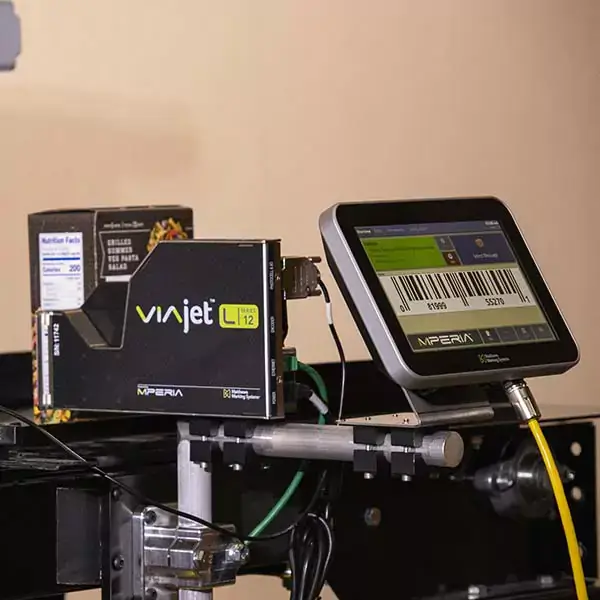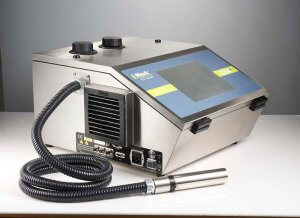Inkjet Printing 101: When and Where to Use Continuous Inkjet vs. Thermal Inkjet for Industrial Coding
From the minute a product enters the production line to the time it leaves the manufacturing facility, it likely has gone through multiple marking events. From barcodes and sell-by dates to carton codes and pallet labels, there are myriad ways that products and packaging are marked for identification, tracking and traceability. Each mark comes with its own set of challenges based on the product, as well as the shape, the size and the material of the item to be printed on. So, the trick for manufacturers is understanding what print technology will be most efficient and reliable for each stage of the process.
The very common industrial print technologies on the market are continuous inkjet (CIJ) and thermal inkjet (TIJ), both of which come with pros and cons and best use-case scenarios. Below we break down the difference between these two technologies and the ideal scenarios for using each.
The basics: How do CIJ and TIJ work?
CIJ has been the dominant solution for small character primary marking for many years. As you can likely tell from the name, CIJ printers use a high-pressure nozzle to spray a continuous stream of ink droplets from the printheads single nozzle, most of which end up in the printhead’s gutter and returned to the ink supply. These droplets may or may not be charged by electrodes and able to be “steered” to create the text or images. When needed, those droplets that are charged are forced through the printing system and used to form the mark. Those that are not charged fall into the gutter and back into the system.
TIJ on the other hand is a “drop on demand” style of printing, using heat to transfer ink and pigments to the desired product, carton or label. The ink stays static until it’s needed, at which point the droplets are rapidly heated and vaporized by a resistor coil, and then ejected from the chamber via pressurized air bubbles (formed from the vaporization) to form a mark, code or image.

Industrial TIJ printers such as the Matthews L-Series, shown here in a turnkey ViaPack configuration, can easily be added to any production line and support a wide range of high-resolution marking applications.
Weighing the pros and cons of CIJ vs. TIJ
With the above in mind, let’s dig into the advantages that CIJ and TIJ bring to the table, as well as some of the downsides. To help illustrate this clearly, we’ve created a chart for both the pros and cons, demonstrating what benefits you would get with each print technology followed by the disadvantages to using each for marking.
Advantages of CIJ vs. TIJ
| CIJ Advantages | TIJ Advantages | |
| Printing/Resolution | Throw distance flexibility: CIJ printers do not need to come in contact with a product for printing and in fact, can be placed a decent distance away. This allows for better marking on fragile or oddly shaped products, such as those with a curve, as well as those that may shift or bounce on the production line. |
High image resolution: TIJ printers can print up to 600×600 dpi, creating a very high-end resolution. This makes TIJs a better option for GS1 compliant barcodes and other marks necessary for medical and pharmaceutical applications. Durability: TIJ printers allow for a longer lasting and more durable final mark, which can withstand many types of weather elements (including cold storage). |
| Ink Issues | Less risk of clogging: With a continuous stream of ink, there is a reduced opportunity for the nozzles to clog and disrupt printing except in challenging environments that produce dust or other residue (e.g., wood or flour bag marking). This can result in debris build-up in the gutter and in some cases can eventually block the recirculating ink from going back to the tank, creating a leak. |
Fewer spills: The cartridge-based design of TIJ printers means less chance of spills as compared to the CIJ machines. Overall, there is much less clean-up and regular maintenance required with a TIJ printer. Cleaner: Advances in TIJ technology have decreased the build-up of ink and debris which can lead to clogging. In addition, automated cleaning (spitting) of the print heads is now being built into more TIJs. |
| Maintenance and Parts |
Availability of parts: The latest CIJ’s have modules that can be replaced and like TIJ need minimal maintenance. |
Fewer parts: TIJ printers have fewer moving parts, so there are fewer opportunities for breakage. Replacements can be done by part, meaning the entire machine doesn’t need to be moved offline for repairs. This decreases downtime for maintenance and increases the reliability of the printers for long-term use. Reduced maintenance costs: While still incredibly robust, TIJs are smaller and more streamlined than CIJs and the only ongoing maintenance cost comes from cartridge replacements – which can be done easily without the support of a specialized expert. |
| Flexibility of Use | Multiple ink options: CIJ printers can work with every day “all purpose” inks, as well as specialty inks. This means that CIJ can be used across applications and industries. In addition, ink from CIJ printers is suitable for a broad range of packaging cartons, labels, and other materials. |
Versatility: TIJ ink can print on a wide variety of surfaces, including porous materials and in small, hard-to-reach spots due to the small print head size. Small footprint: With a more compact size than a CIJ printer, a TIJ can fit into tighter spaces on your production line, whether installing in a small operation or multiple production lines. |
Disadvantages of CIJ vs. TIJ
| CIJ Disadvantages | TIJ Disadvantages | |
| Printing/Resolution |
Image resolution:
|
Throw distance: In comparison to CIJ printers, a TIJ must be within a few millimeters to the product for an accurate mark and the product must be moving in a smooth manner for a TIJ to work properly. That said, TIJ printers with longer throw distances are now starting to come to market, which could improve its viability for many primary packaging applications. |
| Ink Issues | Increased cleaning: Because of the continuous spray of ink, the floor or bench area around a CIJ printer can become coated in ink, requiring specialized cleaners and ventilation to ensure worker safety. |
Less choice: Because of the use of heat with a thermal printer, there can be fewer options for ink type and color. For example, thermal printing may not allow for wax or resin-based inks. TIJ printers may require specialized inks for certain substrates, which can add slightly to the cost of use. |
| Maintenance and Parts | Maintenance of printers/parts: CIJ printers have more parts than TIJ, opening the door for increased breakage — which can take time to repair and create unnecessary downtime on your production line. Often the entire printer must be taken out of commission for repairs since it operates as a single system. CIJ printers require costly annual maintenance to ensure they are providing optimal performance in addition to higher initial costs. |
Cartridge costs: While overall maintenance costs are significantly lower with a TIJ, the replacement cartridges can cost more than some replacement parts on CIJs, however this only applies to the cost of parts and not labor. Depending on the model and configuration, TIJ coders are generally less expensive initially than equivalent CIJ machines. |
| Flexibility of Use | Startup Time: CIJ coders can take several minutes to bootup before printing can begin. This can lead to wasted operator time and unneeded production downtime for example at the start of shifts or following a stoppage. |
Can’t print up: Because of how TIJ printers produce ink droplets, they are not suitable for situations where they need to print pointing upwards, such as on the bottom of a can or bottle. While this can be a concern for primary marking, most secondary packages are printed on the sides or top. |
Determining when to use CIJ vs. TIJ
As laid out above, there are pros and cons to both print technologies. So now, armed with the knowledge of what CIJs and TIJs do and the advantages of both, you might be wondering – which one works best for my application?
While we can’t definitively give you an answer, we can help guide you by providing some general use case scenarios for each:
- CIJ: If you’re printing marks and codes with a fast, continuous production process that utilizes a significant amount of ink (e.g., expiration dates on food packaging), CIJ might be a good fit. This is especially true if you run a production line that operates 24/7 and won’t be impacted by slow startups. In addition, as mentioned above, CIJ printers have more throw distance flexibility, allowing them to print from a distance, over curved or rough surfaces, and/or with products that don’t move smoothly through the production line.
- TIJ: If you need a high-resolution mark, such as for a GS1 compliant barcode, then TIJ is the best print technology to use. In addition, because you can easily swap out the ink cartridges, TIJ is also a great solution if you need to move seamlessly between ink types or colors. And finally, the instant startup and small footprint of a TIJ can’t be beat. So, if you need a small, reliable printer to fit in compact spaces or need larger marks, you’ll definitely want to consider TIJ.

Example of a CIJ printer suitable for industrial applications such as low-resolution coding on primary packaging.
Side by side for the win
If you read the above and thought “I need all of that for my production line!” you’re not alone. There may be one part of your production line that would be best served by CIJ, whereas TIJ would work best for another. Matthews Marking System’s MPERIA platform is the best printer controller technology for this scenario as it can support different printing technologies from one controller. For example, you might need to mark bottles with a CIJ but use a Matthews L-Series TIJ for direct carton marking. With the MPERIA system you can centralize your production operations and simultaneously control all your print technologies from one screen, ultimately increasing productivity and efficiency.
Interested in a demo of how MPERIA can help you support both CIJ and TIJ (and any other print technology) on your production lines? Give us a call at 800.775.7775 or email us at [email protected].
